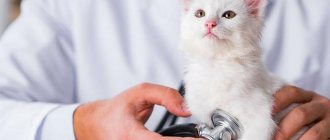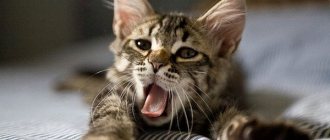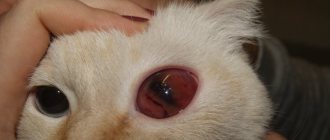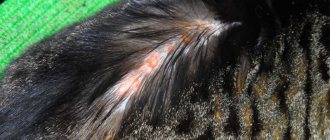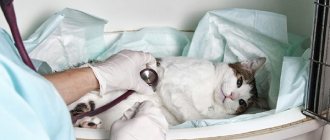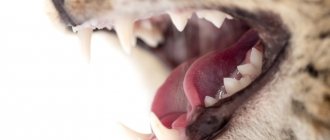Cholecystitis in cats is a disease that can be fatal without timely treatment. Inflammation of the gallbladder is accompanied by severe pain, disruption of the digestive process and symptoms of intoxication.
Cholecystitis is difficult to treat. Therefore, owners should be aware of preventive measures to prevent their pet from developing the disease.
Causes of the disease
Cholecystitis in cats can be caused by various reasons. The most common is cholelithiasis (GSD). As for provoking factors, these include the pet’s sedentary lifestyle, age and impaired gallbladder tone.
The main causes of cholecystitis in cats:
- Poor nutrition. Cheap mass-market food, expired products and a lack of vitamins (especially vitamin B1) provoke the development of inflammatory processes. Pathogenic microorganisms penetrate the gallbladder and cause inflammation.
- Invasive diseases (helminths). A common cause of helminth infection is feeding your pet raw fish or meat. Parasites clog the bile ducts and penetrate the gallbladder, which leads to disruption of its functions.
- Blockage of the bile ducts. The main reasons that can lead to this condition: cholelithiasis (GSD), pancreatic tumor, etc. All this provokes the development of an acute inflammatory process.
- Infectious diseases . Both bacterial and viral infections can lead to gallbladder inflammation. Among the most dangerous diseases leading to cholecystitis: leptospirosis, viral hepatitis, “feline distemper”, etc.
- Damage or rupture of the gallbladder. It occurs when there is a serious mechanical injury: a cat falling from a great height, strong impacts, collisions, etc. Chronic inflammation can also lead to perforation (breaking through) the walls of the gallbladder.
Symptoms and first signs of the disease
During attacks of acute cholecystitis, it is very important to provide first aid in a timely manner and deliver the animal to the clinic.
The most characteristic signs of the disease are:
- frequent vomiting mixed with bile;
- increase in temperature indicators by 1-1.5°;
- refusal of food;
- lethargy, apathy, avoidance of unnecessary movements, desire for solitude;
- pain when pressing on the area of the right hypochondrium;
- discoloration of stool;
- yellowness of the sclera of the eyes, conjunctiva and visible mucous membranes.
Note! Quite often, jaundice with cholecystitis appears only on days 3-5, and sometimes it can occur after the attack has subsided. Therefore, you should not wait for this symptom to contact a veterinarian.
The following clinic indicates a rupture of the gallbladder:
- a sharp deterioration in the general condition of the pet;
- severe pain and tension in the abdominal wall;
- anemia of the mucous membranes and inner surface of the ears;
- a sharp drop in temperature below normal.
Note! Normal temperature in cats, depending on breed and age, varies from 38 to 39°C.
The result of a rupture of the gallbladder is the leakage of its contents into the abdominal cavity. Bile acids and liver enzymes quickly begin to corrode soft tissues, provoke inflammation and the development of peritonitis. In this case, only emergency surgery can save the cat.
A pet suffering from chronic cholecystitis may have no clinical signs during a period of stable remission. But more often there is a sluggish course of the pathology, manifested by the following symptoms:
- decreased appetite;
- periodic digestive disorders with alternating diarrhea and constipation;
- light color of feces;
- the urge to vomit after eating food;
- gradual loss of body weight with a unchanged diet.
A relapse can be triggered by a cat falling from a great height, abdominal compression, severe stress, or eating fatty, smoked or salty food from the owner’s table.
Symptoms of cholecystitis in a cat: what to look for?
The first thing that indicates cholecystitis in your pet is nausea and vomiting containing bile. A sick cat refuses to eat and therefore rapidly loses weight. Due to the inflammatory process, she will experience increased body temperature and general weakness.
The main symptoms of cholecystitis in cats:
- nausea and vomiting,
- bloating of the abdominal area,
- increase in body temperature,
- lethargy and apathy,
- constipation,
- peeling of the mucous membranes of the oral cavity,
- yellowness of the sclera of the eyes.
In severe forms of cholecystitis, the cat experiences severe pain. She meows loudly, behaves aggressively, does not allow the abdominal area to be touched, etc. Fever may develop (for example, if cholecystitis is caused by an infectious disease).
Treatment and prognosis
If symptoms of cholecystitis are detected in cats, you cannot treat them yourself. This can be fatal due to dehydration, excessive intoxication, or rupture of the gallbladder.
Important! Before arriving at the clinic, you should not give your cat painkillers or antispasmodics, which can hide the true picture of cholecystitis and complicate diagnosis.
If there are symptoms of severe cholecystitis, experts suggest treating cats in a hospital setting, where they will be prescribed and given full treatment.
Conservative
On the first day of acute cholecystitis, the animal is prescribed a starvation diet, complete rest and symptomatic therapy, which includes the following groups of medications.
| Prescription of drugs | Medications |
| Relieving inflammation and eliminating pathogenic microflora | Metronidazole, Kefzol, Cobactan, penicillin drugs |
| Relieving smooth muscle spasm | No-shpa, Papaverine |
| Improving bile flow | Odeston, Ursosan |
| Preventing Dehydration | intravenous injections of saline or Ringer's solution with glucose |
| Maintaining heart muscle function | Cordiamine, Caffeine Sodium Benzoate |
With the parasitic etiology of cholecystitis, cats are prescribed anthelmintic drugs.
Important! To improve liver function, experts advise administering B vitamins to cats.
In parallel with treatment for cholecystitis, the doctor prescribes a strict diet, on compliance with which the effectiveness of treatment largely depends. The animal's diet should include:
- dairy products;
- rice;
- boiled or baked vegetables (carrots, zucchini);
- puree from boiled dietary meat or fish;
- low-fat meat broths.
Meals should be fractional. Food must be given crushed and warm, in small portions. Fatty foods, raw fish and meat, whole milk, sweets and baked goods should be completely excluded from the diet.
Surgical
If the gallbladder ruptures, laparotomy is used, followed by the prescription of antimicrobial and anti-inflammatory drugs.
When stones are detected, if the integrity of the organ is not compromised, the laparoscopic method is often used to remove it.
Forms of cholecystitis: acute and chronic
Spicy . Often develops in cats against the background of cholelithiasis (GSD). The gradual accumulation of bile leads to infections and acute inflammation of the walls of the gallbladder. Acute cholecystitis develops rapidly - within a few days or even hours.
Chronic . It occurs as an independent disease, and the entire clinical picture develops gradually. Temporary improvements in the condition are possible. The main danger of chronic cholecystitis is the difficulty of timely diagnosis.
Preventive measures
Almost all liver diseases in cats are preventable. For this it is necessary
:
- Choose the right diet for your pet, monitor its diet and drinking habits.
- Take medications strictly as prescribed by your veterinarian and only when necessary.
- Make sure that any chemicals are out of the cat's reach.
- Maintain the level of vitamins in the animal’s body at a normal level.
- If your cat is prone to liver diseases, give him hepatoprotectors and follow a diet.
Remember that any disease is better to prevent than to cure.
In this article you can find a lot of useful information that is related to solving one of the common health problems in pets, but you need to understand that this is only informational information, since treatment should only be prescribed by a veterinarian.
Cholecystitis in cats: what is it, symptoms and signs, causes and prognosis
If the acute form is not treated, it can develop into a chronic form, which may not show itself for years, and at one point the gallbladder will simply explode and the pet will need to be operated on urgently. That is why the disease is serious and needs to be dealt with appropriately and with the help of veterinarians.
Chronic cholecystitis in cats and its description, features of treatment and diagnosis
Chronic cholecystitis may not be felt for a long time and is as serious a disease as its acute form. Often manifested by mild symptoms that need to be taken into account are: - nausea after eating; - constipation; - stomach upset; - weight loss.
It is difficult to detect and understand that your pet has chronic cholecystitis at home, so it is usually discovered by chance, during a routine examination. To fully define this disease, you will have to work hard. You need to take a general and biochemical blood test, a urine test, an ultrasound of the liver and gall bladder.
In severe cases of the disease, treatment can continue only after surgery, but if the disease is discovered and there is no reason to expect rupture of the gallbladder, then doctors often resort to the use of therapeutic agents. In this case, a feature of such treatment is strict adherence to the diet prescribed by the veterinarian.
Cholecystitis in cats, what tests to take, where and how much they cost
They take an ultrasound of the gallbladder and liver, as well as a biochemical blood test and a blood test, which can be done at any veterinary hospital. The cost of diagnostics at each veterinary hospital varies.
Cholecystitis in cats treatment at home and in a veterinary clinic, drugs
It is not recommended to treat cholecystitis at home, but there are preventive measures, using them you can never encounter such diseases: - The cat needs a rational, balanced diet. — It is necessary to regularly deworm your pet. — Be sure to vaccinate your cat on time. — Toxic substances: household chemicals and other chemicals should be stored in places inaccessible to cats.
In the treatment of cholecystitis, it is important to follow the doctor’s instructions and follow the correct diet for the cat. Each situation is individual and therefore there are no template instructions. The veterinarian is advised to buy specialized food and switch the animal to a low-fat diet.
A popular dish is made from rice and meat (one to one), which the pet will happily eat and will not cause much trouble for the owner to quickly prepare it, but if such a dish is not in the diet prescribed by the veterinarian, then it is not recommended to feed it with anything else.
The article will discuss a problem that occurs only in some pets, but this does not mean that it is not serious and...
Cats are very neat animals, but sometimes owners notice that some kind of bump has appeared on the tail of their pets. What could it be? Lump n...
The liver is a biological filter of the body, performing the following functions: detoxification, metabolic, excretory, hematopoietic, immune, and is also a depot of vital elements. In recent years, liver diseases in cats have often been registered at the DobroVet EC.
Toxins (poisons, metabolic products, allergens) enter the bloodstream from the gastrointestinal tract into the liver parenchyma, where they are neutralized. In some cases, the liver is not able to neutralize all harmful substances, which leads to a pathological process in its tissues. Liver pathologies such as hepatosis, hepatitis, cholelithiasis, liver cirrhosis, and cholecystitis occur in cats.
Main signs of diseases
Liver diseases in cats and the symptoms associated with them have practically no pathognomic signs (except for jaundice). Indirect signs and symptoms of liver pathologies:
Dyspeptic syndrome (vomiting, stool disorder);
Jaundice – yellow discoloration of the skin, mucous membranes, sclera due to the deposition of bilirubin;
Itchy skin;
The color of urine is dark, even brown;
Hepatic coma;
The feces are discolored, gray-clay;
Ascites - an increase in abdominal volume due to effusion into the abdominal cavity;
Hepatomegaly with protrusion through the abdominal wall;
Pain syndrome - hepatic colic;
Hemorrhagic syndrome, petechiae;
Anemia, thrombocytopenia;
Coagulation disorder.
The main clinical signs of liver pathology in cats include jaundice, which occurs due to a violation of the excretory function of the liver. Jaundice can be mechanical, parenchymal and hemolytic.
With mechanical (posthepatic) jaundice, due to obstruction of the bile ducts, the outflow of bile into the intestine is disrupted, which leads to digestive disorders. Obstructive jaundice is characterized by cholemia, a symptom complex that occurs when all components of bile enter the bloodstream. Cholemia is often accompanied by itchy skin.
Parenchymal (hepatic) jaundice occurs due to damage to hepatocytes. Inflammatory (and other) damage to the parenchyma leads to a disruption in the utilization of toxins, as a result of which they enter the systemic circulation.
With jaundice arising in connection with hepatic pathology, it is necessary to differentiate hemolytic - suprahepatic - jaundice (assessment of direct and indirect bilirubin in the blood serum).
Brief characteristics of diseases
Hepatitis and hepatosis
Acute and chronic inflammatory processes. Causes:
Intoxication with organic and mineral poisons;
Exposure to toxins resulting from infectious or immune diseases;
Overdose of drugs, use of hepatotoxic drugs.
Signs:
Jaundice;
Temperature increase;
Decreased appetite, polydipsia;
Stool disorders (diarrhea or constipation), discolored, gray stools;
In the terminal stage, convulsions are observed.
The diagnosis is made based on the clinical picture, laboratory tests of urine (bilirubin) and blood (bilirubin, transaminase activity, alkaline phosphatase).
For liver diseases in cats, treatment tactics depend on the factor that caused the disease. A diet with the exception of fats is indicated. On the first day - fasting, after which a high-carbohydrate diet (porridge) is prescribed; after a week, meat is gradually added to the diet.
Basic principles of therapy:
Prescription of B vitamins and choline-containing drugs (Essentiale, etc.);
Prescription of antispasmodic drugs to relieve pain and cholestasis;
Antibiotic therapy;
Infusion of saline solutions for dehydration;
Prescribing glucose with vitamin C to relieve intoxication;
Anti-inflammatory (glucocorticosteroids) and antihistamines.
Cirrhosis
In cirrhosis, the parenchyma is replaced by connective tissue, which leads to disruption of the basic functions of the organ.
Causes: history of hepatitis, prolonged intoxication of the body, protein starvation, lack of B vitamins, diseases of viral and bacterial etiology.
Signs: decreased appetite, diarrhea, conjunctival hemorrhages, jaundice, ascites, palpable liver compaction, shortness of breath, cardiac dysfunction.
The diagnosis is made on the basis of anamnesis, clinical picture, laboratory data (clinical and biochemical analysis of blood and urine) and ultrasound data.
Treatment: prescription of glucocorticoids, calcium and potassium preparations to correct the electrolyte balance of the blood, choleretic drugs and diuretics, vitamin therapy (vitamins A, E, C, B).
Cholelithiasis
The disease is characterized by the formation of stones in the gallbladder and bile ducts. It is rare in cats. Causes: history of hepatitis, cholestasis, disorders of the anatomical structure of the bile ducts, hypovitaminosis A.
Signs:
Pain syndrome – hepatic colic;
Jaundice, in some cases increased body temperature;
Digestive disorders, foul stool.
Diagnosis: difficult, based on ultrasound data and laboratory blood tests.
Treatment: symptomatic, analgesic and antispasmodic drugs are prescribed. The possibility of surgical treatment is being considered.
Cholecystitis
Inflammation of the gallbladder. Causes: formation of stones in the gall bladder, giardiasis (protozoal invasion).
Signs: pain, increased body temperature, unstable stool (diarrhea is replaced by constipation).
Diagnosis: difficult, made on the basis of anamnesis, clinical picture, and laboratory blood test data.
Treatment: easily digestible diet, antibiotic therapy, physiotherapy (contraindicated in acute and purulent processes!), choleretic drugs.
Prevention
Prevention of liver pathologies in cats involves preventing infections and infestations through regular vaccination and deworming. A balanced diet, limiting access to poisonous and toxic substances.
Questions for the veterinarian
Can cats have tumors in their liver, and what is their prognosis?
Yes, different types of tumors can form: primary, formed directly in the liver in cats, or secondary, transferred from other organs. Liver tumors have a poor prognosis for cats.
What is hepatic purpura?
Amyloidosis, hepatic purpura, is a disease in which a protein (amyloid) is deposited in the liver, gradually destroying it, disrupting the normal functioning of the organ. Provokes rupture and hemorrhage. “Hepatic purpura” can occur without amyloidosis, when cavities filled with blood form in the liver.
What is the diagnosis of liver disease in cats?
In case of diseases, a comprehensive, accurate and thorough diagnosis is carried out. This includes: medical history, clinical signs, laboratory tests, additional methods. The full picture of the disease can only be revealed in a veterinary center.
Veterinary
The liver is a vital organ in the animal’s body, performing a large number of different physiological functions.
The liver serves as a filter in the body; it is involved in the processes of food digestion, metabolic functions and blood circulation, and also ensures the normal state of the internal environment.
Various harmful elements, such as toxins and allergens, penetrate through the blood into the liver and are neutralized there. Sometimes the liver fails to completely neutralize the poison, in which case an inflammatory process begins.
Cats, like people, have liver problems such as hepatitis, cholelithiasis, cirrhosis, hepatosis, cholecystitis.
Methods for diagnosing the disease
If you suspect that your cat has cholecystitis, contact a veterinary clinic in Moscow immediately. The first thing a specialist will do is conduct a diagnosis. He will not be able to make an accurate diagnosis based on symptoms alone, so additional research will be required.
Appointed:
- general/biochemical blood test,
- ultrasound diagnostics,
- fine needle biopsy,
- scintigraphy (functional imaging) of the gallbladder,
- differential diagnosis.
With cholecystitis, the level of bilirubin (from 7.9 µm/l), alkaline phosphatase and cholesterol increases in a cat. When determining the diagnosis, the veterinarian also takes into account the level of bile acid and endogenous enzyme from the transferase group.
Diseases that can affect a cat's liver
There are many ailments known to medicine, but the most common liver diseases in cats are:
:
- Cirrhosis.
- Types of hepatosis – amyloidosis, lipidosis.
- Hepatitis.
- Cholangitis – neutrophilic, lymphocytic.
Other known diseases are rare
.
Cirrhosis
Cirrhosis of the liver is an excessive proliferation of connective tissue in the organ, which entails structural changes and disturbances in its functioning. The cause of the disease can be hidden infections, lack of B vitamins, and prolonged intoxication in small doses. For treatment, diuretics, choleretic drugs, potassium, calcium to restore hematopoietic function, vitamin complexes, and glucocorticoids are prescribed.
Amyloidosis
In amyloid disease, one or more specific types of protein accumulate in the liver. The main reason is the cat’s genetic predisposition
. Proteins collecting in the organ provoke malfunctions and the subsequent occurrence of tissue ruptures with heavy bleeding into the abdominal cavity. The disease cannot be completely cured. To relieve exacerbation, anti-inflammatory drugs, colchicine, are prescribed. In severe cases, the damaged liver tissue is surgically removed. A cat diagnosed with amyloidosis must always be on a special diet.
Lipidosis
The disease is characterized by the accumulation of fats in the liver cells, which cause swelling of the organ, its damage and subsequent severe dysfunction. The main sign signaling a possible disease is a sudden refusal to eat. The main reasons for its occurrence are considered to be excess weight, metabolic disorders, and improper nutrition of the cat.
Feline lipidosis confirmed after liver biopsy
. For treatment, the cat must be hospitalized. At the veterinary clinic, she will be prescribed a special diet, which must be strictly adhered to; food must be administered using a special medical tube until her appetite and ability to eat on her own are restored. After complete recovery, the cat begins a recovery stage that lasts up to several months.
Hepatitis of various origins
Diseases of the group are divided into two types
:
- Infectious
. The breakdown of liver cells occurs due to the presence and rapid spread of various pathogenic microorganisms in the cat’s body. Most often it is a complication of the underlying disease. First of all, antiviral drugs are prescribed, then vitamin complexes, glucose and a restorative diet. - Toxic.
They arise as a result of poisoning with toxic substances of varying degrees of severity. They are treated with detoxification using medications, following a strict diet and drinking regime.
Cholangitis
Neutrophilic cholangitis is a disease caused by bacteria that enter the liver from the cat's intestines. To cure a pet, he is prescribed antibiotics. Complications are extremely rare, and the disease is highly treatable.
Lymphocytic cholangitis - leads to inflammation and enlargement of the liver, accumulation of fluids in it and the abdominal cavity. The exact causes of the disease have not yet been clarified. For treatment I use anti-inflammatory drugs and immunomodulators. Usually recovery occurs quickly, but there are cases when the disease becomes chronic and requires lifelong medication.
How and with what to treat cholecystitis in cats?
Treatment of cholecystitis is determined by a veterinarian individually in each specific case. It takes into account the initial cause of the disease, its stage and severity. Under no circumstances resort to self-medication or folk remedies - this will only harm your cat.
Drug (conservative) treatment . It gives a good result, but only in the initial stages of the disease. The veterinarian prescribes symptomatic medications of various effects:
- antiviral,
- antispasmodic,
- anti-inflammatory,
- painkillers,
- antipyretics, etc.
To eliminate inflammation of the gallbladder, a long course of antibiotic drugs is prescribed. First, the doctor determines the sensitivity of the pathogenic flora to the action of drugs.
Additionally, to speed up and ensure the discharge of bile, plant-based decoctions are used (for example, plantain leaves, dandelions, etc.). In case of severe intoxication of the body, infusion therapy is prescribed.
In parallel with antibiotic drugs, vitamin and mineral complexes are prescribed. Vitamins A, group B (B1, B2, B6 and B12), as well as C are used. If necessary, drugs are prescribed that restore heart function.
Surgical (operative) treatment . Surgical interventions are prescribed if conservative treatment does not produce a successful result. Other indications for surgery include: blockage of the bile ducts, rupture of the gallbladder, frequent relapses of the disease.
Removal of the gallbladder is performed using laparoscopy. If the bladder ruptures or if a complication is detected (for example, an infectious disease), a laparotomy is prescribed. A blood clotting test is performed first.
List of drugs and antibiotics
The above list of medications and antibiotics is given for informational purposes only, and not for self-treatment of cholecystitis in your pet. Their dosage and duration of therapy should only be determined by a veterinarian.
- Antispasmodics: no-spa;
- spazgan;
- papaverine;
- platiphylline.
- cephalosporins (ceftriaxone, cefazolin, cefotaxime, cephalexin, ceftazidime, cephalen);
- tavegil;
- azinox;
- ursodeoxycholic acid;
What to feed a cat with cholecystitis?
When treating cholecystitis, your pet must be switched to a special balanced diet. It is recommended to continue the diet until the cat’s condition is completely restored. This takes about 2-4 weeks.
It is necessary to completely exclude fried and fatty foods with a high cholesterol content from the animal’s diet: lamb, sausages, butter, canned fish, condensed milk, etc.
Products that can be included in your cat's diet:
- low-fat meat or fish broth,
- rice or oatmeal porridge,
- rice water,
- boiled vegetables (carrots, potatoes),
- lean minced chicken,
- light cottage cheese.
Etiology, symptoms and therapy of cholestasis
Possible causes of bile stagnation in cats:
- Parasitic infections. Most often, the disease is provoked by trematodes that live in the bile ducts. Single “residents” in the liver do not cause any particular harm to the animal. When there are many of them, they clog the lumens of the bile ducts. Other dangerous parasites are echinococci and alveococci, the larvae of which can be “preserved” in the internal organs, forming large blisters that compress the bile ducts.
- Malignant neoplasm . The tumor can compress the liver tissue, preventing bile from freely exiting into the intestinal lumen.
- Intoxication of the body , due to which the cat may develop cirrhosis. As they grow, the connective tissue “ties” compress the parenchyma of the organ so much that the secretion physically cannot be removed into the duodenum.
- Stones in the gallbladder , most often formed in elderly and neutered cats. If there are many stones and they are small, they are highly likely to provoke cholestasis.
- Infectious diseases that can lead to inflammation of the gallbladder. Exfoliated cells and tissues form a thick mass, often blocking the exit from the gallbladder and causing stagnation of bile.
The symptoms of this disease are variable and depend on the cause of its development. It is usually accompanied by:
- lethargy, apathy, decreased motor activity, lack of response to external stimuli;
- lack or, on the contrary, increased interest in food (the cat can absorb food in large quantities, try inedible objects);
- attacks of nausea and vomiting (the pet constantly or periodically feels sick and vomits, regardless of food intake);
- weight loss;
- yellowness of the mucous membranes and skin;
- change in the color of urine and feces (urine becomes orange or dark, feces become light, almost colorless).
Effective recommendations for disease prevention
The first and most important rule is do not feed your pet raw meat or fish. Give him all foods only after heat treatment. This will prevent helminth infection and reduce the likelihood of developing cholecystitis.
Preventive recommendations:
- Carry out anthelmintic treatment once a year,
- Vaccinate your cat promptly
- do not allow severe mechanical injuries,
- buy only high-quality food,
- alternate dry and wet food,
- 1-2 times a year, contact a veterinary clinic for preventive examinations.
Cholecystitis is a disease that, without timely and professional treatment, can lead to dangerous consequences for your pet, including death. However, it is possible to prevent this from happening.
The main thing is to entrust the treatment of your beloved pet to experienced veterinarians. In this case, the prognosis is completely favorable!
Prevention measures
It is possible to prevent cholecystitis in your cat if you follow some preventive recommendations. It is worth monitoring your pet’s diet; it should be regular and balanced. If owners give their pet food, they must be sure of its high quality. It is important to monitor the cleanliness of the dishes from which the animal eats and drinks. Regular deworming and treatment of cat fur from parasites will help avoid cholecystitis. It is necessary to use vitamin complexes that strengthen the immune system.
Description
Cholecystitis is an acute or chronic disease in which the animal’s gallbladder becomes inflamed.
The gallbladder is the place where bile is collected. Its concentration in the bubble increases approximately 5 times. A cat's gallbladder consists of a neck, body and fundus. The wall consists of mucous membrane, peritoneum, muscle and connective tissue. The cystic duct originates in the gallbladder and connects to the hepatic duct. They eventually form a bile duct, which drains into the duodenum. At the junction there is a sphincter, which makes it possible for bile to enter the intestines and bladder.
Clinical signs
What symptoms will indicate that it is time for your cat to visit the veterinarian? You definitely won't miss them. Firstly, the animal’s behavior becomes lethargic, the cat sits or lies in one place for a long time, not showing any interest even in the most delicious food. In many cases, jaundice develops. At first, the yellow color can only be seen on the outer mucous membranes, but soon the skin becomes the same. The feces become very pale, become viscous, “greasy” and semi-liquid. This is due to the fact that fats that were previously absorbed by the cat’s body now pass into feces almost unchanged. Due to the lack of lipids, the skin becomes dry and its elasticity decreases significantly. Frequently profuse
What it is?
The term describes a pathological condition that develops when bile synthesized by the liver, for some reason, does not enter the lumen of the duodenum, but remains in the gallbladder or ducts of the organ. There it begins to be absorbed into the blood, causing a severe condition, cholemia. The latter often leads to the death of the animal, since bile itself is an extremely toxic and aggressive compound.
There can be many reasons for the illness. Perhaps we should start with parasitic diseases. The real hit is opisthorchiasis. This is a disease caused by the trematode Opisthorchis felineus. The parasite feels great living directly in the bile ducts, and its method of movement resembles the movement of a stingray. The worm actively eats and does not deny itself anything. If there are one or two “residents” in the liver, nothing particularly terrible happens, but when there are many of them, the bodies of the parasites can plug the lumens of the bile ducts.
Approximately the same group of causes includes echinococcus and alveococcus. The larvae of these parasites can be “preserved” in the internal organs, forming blisters of decent size (up to the size of a large orange). If such a tumor grows in the liver, it may well compress the bile ducts.
The effects of toxic substances on the cat's liver.
Because the liver is involved in drug metabolism, some drugs can cause liver dysfunction in cats. Specific signs and effects are associated with specific medications and their doses. In many cases, the veterinarian must consider the drug's potential for liver harm when prescribing treatment and monitor the cat for any signs of decreased or altered liver function. Substances that are toxic to the liver include heavy metals, some herbicides, fungicides, insecticides, rodent poisons, aflatoxins (produced by fungi), some fungi and blue-green algae.
If your cat accidentally receives an overdose of medication, reacts poorly to the prescribed dose, or ingests toxic substances, you should immediately consult a doctor. If necessary, the veterinarian will take actions aimed at reducing the absorption of toxic substances. Depending on the situation, the cat is induced to vomit, activated charcoal is used, the stomach is washed, or an appropriate antidote is prescribed. Any information related to a possible toxin can help the doctor choose the right treatment.

